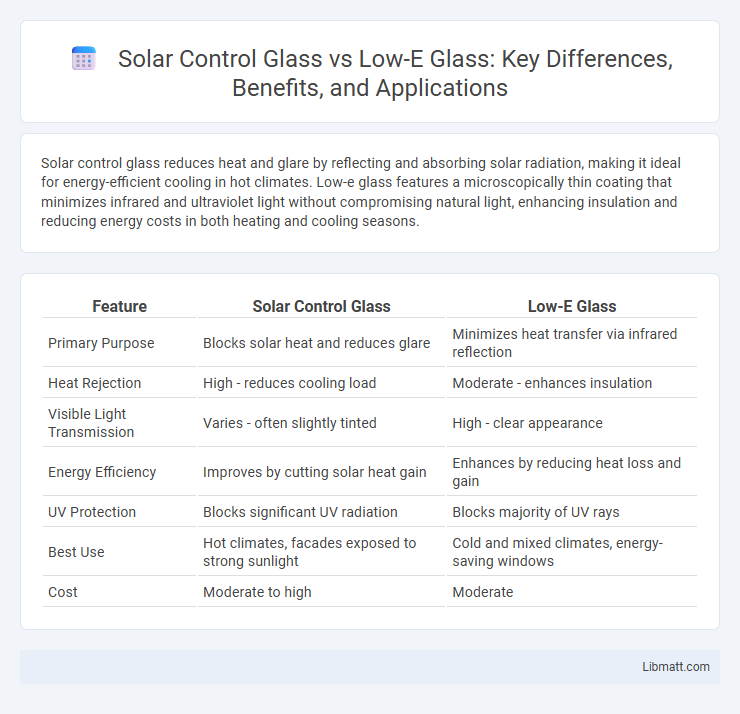Solar control glass reduces heat and glare by reflecting and absorbing solar radiation, making it ideal for energy-efficient cooling in hot climates. Low-e glass features a microscopically thin coating that minimizes infrared and ultraviolet light without compromising natural light, enhancing insulation and reducing energy costs in both heating and cooling seasons.
Table of Comparison
| Feature | Solar Control Glass | Low-E Glass |
|---|---|---|
| Primary Purpose | Blocks solar heat and reduces glare | Minimizes heat transfer via infrared reflection |
| Heat Rejection | High - reduces cooling load | Moderate - enhances insulation |
| Visible Light Transmission | Varies - often slightly tinted | High - clear appearance |
| Energy Efficiency | Improves by cutting solar heat gain | Enhances by reducing heat loss and gain |
| UV Protection | Blocks significant UV radiation | Blocks majority of UV rays |
| Best Use | Hot climates, facades exposed to strong sunlight | Cold and mixed climates, energy-saving windows |
| Cost | Moderate to high | Moderate |
Introduction to Solar Control Glass and Low-E Glass
Solar control glass minimizes heat gain by reflecting infrared radiation while maintaining visible light transmission, enhancing energy efficiency in buildings. Low-E glass features a microscopically thin coating that reduces ultraviolet and infrared light penetration without compromising natural daylight, improving thermal insulation. Both technologies optimize indoor comfort and reduce reliance on air conditioning by controlling solar radiation and heat transfer.
How Solar Control Glass Works
Solar control glass works by reflecting and absorbing a significant portion of the sun's infrared and ultraviolet rays, reducing heat transfer and minimizing glare inside buildings. Its special coatings or tints block solar heat while maintaining visible light transmission, enhancing energy efficiency and comfort. You can improve indoor temperature regulation and reduce cooling costs with solar control glass compared to standard low-e glass, which primarily targets heat retention rather than heat rejection.
Low-E Glass: Technology and Functionality
Low-E glass features a microscopically thin coating that reflects infrared energy while allowing visible light to pass through, enhancing energy efficiency by reducing heat transfer in buildings. This technology significantly lowers heating and cooling costs by maintaining indoor temperature stability and minimizing UV ray penetration, which protects interiors from fading. Compared to solar control glass, Low-E glass prioritizes thermal insulation and energy savings over direct solar heat reduction, making it ideal for climates with significant temperature variations.
Key Differences Between Solar Control and Low-E Glass
Solar control glass primarily reduces heat gain from sunlight by reflecting infrared radiation, effectively minimizing cooling costs and glare in buildings. Low-E glass features a microscopically thin metallic coating that enhances insulation by reflecting interior heat back inside, improving energy efficiency in both winter and summer. While solar control glass excels at blocking solar heat, low-E glass optimizes thermal insulation, making each suited for different climate and energy needs.
Energy Efficiency Comparison
Solar control glass reduces heat gain by reflecting and absorbing solar radiation, making it ideal for hot climates to lower cooling costs. Low-E glass enhances energy efficiency by minimizing heat transfer through its microscopically thin coating, keeping interiors warmer in winter and cooler in summer. Your choice between the two depends on whether controlling solar heat gain or improving overall thermal insulation is the priority for your space.
Impact on Natural Light and Visibility
Solar control glass reduces glare and limits the amount of infrared heat entering your space while maintaining clear visibility, making it ideal for environments with intense sunlight. Low-E glass is coated to minimize ultraviolet and infrared light without significantly affecting the transmission of visible light, preserving natural brightness and clarity through the window. Both types enhance comfort by managing solar heat gain, but solar control glass offers greater protection against excessive brightness, whereas low-E glass ensures maximum natural light and unobstructed views.
Applications in Residential and Commercial Buildings
Solar control glass is primarily used in commercial buildings to reduce glare and minimize heat gain, enhancing occupant comfort and lowering cooling costs. Low-e glass is favored in residential buildings for its superior insulation properties, reducing heat loss in winter and heat gain in summer to improve energy efficiency. Both types contribute to sustainable building designs by optimizing natural light while maintaining thermal comfort.
Cost Considerations and Return on Investment
Solar control glass typically has a lower upfront cost compared to low-e glass, making it an attractive option for budget-conscious projects. Low-e glass, with its advanced coating technology, offers higher energy efficiency by minimizing heat transfer, resulting in greater long-term savings on heating and cooling bills. The return on investment for low-e glass is generally higher due to its superior performance in reducing energy consumption, despite the initial higher price.
Durability and Maintenance
Solar control glass offers high durability with its coatings designed to withstand harsh weather conditions, reducing the risk of fading or damage over time. Low-e glass features a thin metallic coating that maintains its effectiveness without requiring frequent cleaning, making maintenance minimal and straightforward. Your choice between these glasses impacts long-term upkeep, with both options providing resilient performance but differing slightly in surface sensitivity and care requirements.
Choosing the Right Glass for Your Project
Solar control glass reduces heat transmission by reflecting solar radiation, making it ideal for buildings in hot climates seeking energy efficiency and interior comfort. Low-e glass features a microscopically thin coating that minimizes infrared and ultraviolet light without compromising natural light, suitable for projects prioritizing insulation and reducing heating costs. Selecting the right glass depends on climate conditions, project goals for thermal performance, and overall energy savings requirements.
solar control glass vs low-e glass Infographic

 libmatt.com
libmatt.com